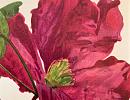Antiques for Sale | Antique Furniture | Antique Fairs | Antiques Listings | Antiques Email Alerts | Websites for Antique Dealers | Contact

Greystones Fine Interiors
Tel : 07425 298868
Email : ian@greystonesfineinteriors.com
Web : www.antiques-atlas.com/greystonesfineinteriors/
Private dealer
by appointment only
Near Peterborough
Cambridgeshire
By appointment only, please ring or email with all enquiries.
Double Dahlias Lithograph. Pierre-Joseph Redoute


Description
Pierre-Joseph Redouté (1759-1840) was one of the most talented botanical artists ever known. He is also possibly the most popular botanical artist in history - his sharpened observation and individual creativeness distinguishing him as a true artist as opposed to being an illustrator. Redouté was fortunate to become an artist who was patronized by the kings of France from Louis XVI to Louis-Philippe. His profile also has a unique claim to fame. His status and reputation was enhanced in no small way due to his patronage by two of the premier first ladies of European history - Marie Antoinette and Josephine Bonaparte. Whilst he is most famed for Les Roses (1817 - 21) he also created extraordinary studies of Fruits and Flower, a collection of which we offer. Redouté's original watercolours are characterised by subtle gradations of tone and when exploring methods for accurately reproducing his paintings Redouté's selected stipple engraving which produced simply astonishing and exquisite plates. Redouté's plates have artistic value, and botanical and documentary value, both for the species and cultivars still surviving and for those that have disappeared.Here we are delighted to offer a fine and wonderful Crimson Double Dahlia study by Pierre-Joseph Redouté. Dahlia is a genus of bushy, tuberous, herbaceous perennial plants native to Mexico and Central America. There are 42 species of dahlia, with hybrids commonly grown as garden plants. The stems are leafy and can be very tall. Each floret is a flower in its own right, the modern name Asteraceae refers to the appearance of a star with surrounding rays. The majority of species do not produce scented flowers. Like most plants that do not attract pollinating insects through scent, they are brightly colored, displaying most hues, with the exception of blue. The dahlia was declared the national flower of Mexico in 1963. The tubers were grown as a food crop by the Aztecs, but this use largely died out after the Spanish Conquest. Attempts to introduce the tubers as a food crop in Europe were unsuccessful.
The lithograph was printed by hand in 1954 by K.G. Lohse of Frankfurt, made using the original 'stipple' engraving plate from the hand of Pierre Joseph Redouté. This plate is near identical to those produced with Redouté's oversight, the deep tones, textures, details are astonishing. This is a very, very fine plate indeed.
The lithograph is mounted in a luxury handmade, hand-finished and wonderfully gilded hammered wooden frame with a confidently proportioned decorated mount. A fine gold fillet has been added as a very sophisticated contrast for the plate. The frame is renaissance gold (the main face features thick foil incorporating real gold) and with good light this piece just glows, with a wonderful, deep and warm gold tone (even our professional photographs can't adequately capture the beautiful frame colour). The glass is museum quality with low reflection, amazing colour transparency and high U.V. absorption to protect the works. The archival acid-free materials and professional techniques used to protect and frame this work will ensure that it continues to be enjoyed for many decades to come.
The framed Lithograph measures 57cm tall by 48cm wide.
The work can be shipped, at cost, within the UK or Internationally.
Date1950s :
1958
ArtistPierre-Joseph Redout
Codeas1081a152
Price £145.00  €172.81
€172.81  $176.20
$176.20  The price has been listed in British Pounds.
The price has been listed in British Pounds.
Conversion rates as of 13/JAN/2025.
Euro & Dollar prices will vary and should only be used as a guide.
Always confirm final price with dealer.StatusFor Sale SellerGreystones Fine Interiors Telephone07425 298868Non UK callers :+44 7425 298868 Emailian@greystonesfineinteriors.com
 €172.81
€172.81  $176.20
$176.20  The price has been listed in British Pounds.
The price has been listed in British Pounds.Conversion rates as of 13/JAN/2025.
Euro & Dollar prices will vary and should only be used as a guide.
Always confirm final price with dealer.StatusFor Sale SellerGreystones Fine Interiors Telephone07425 298868Non UK callers :+44 7425 298868 Emailian@greystonesfineinteriors.com
Contact
Send Greystones Fine Interiors a message about this item here


